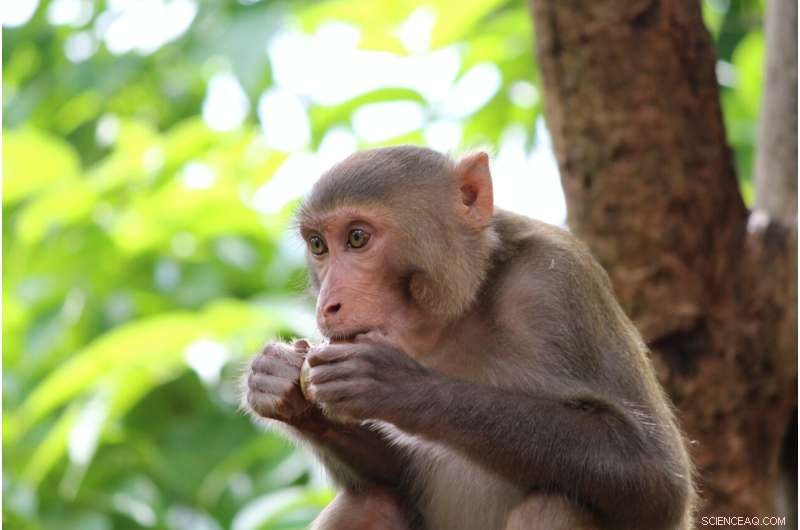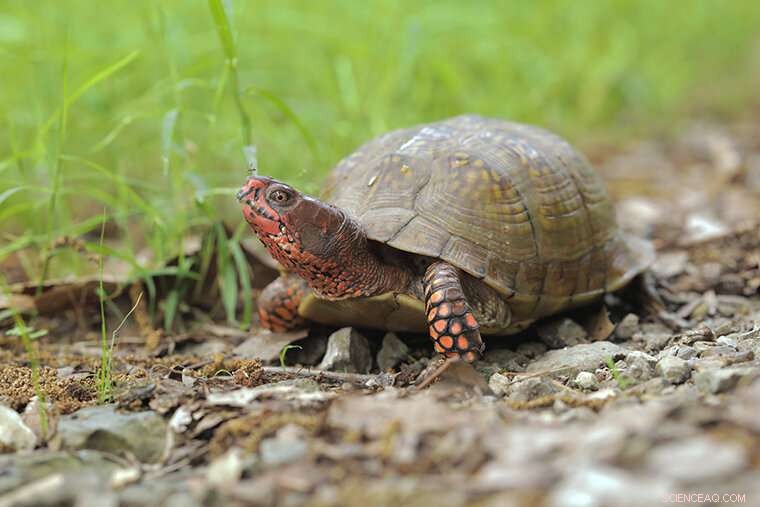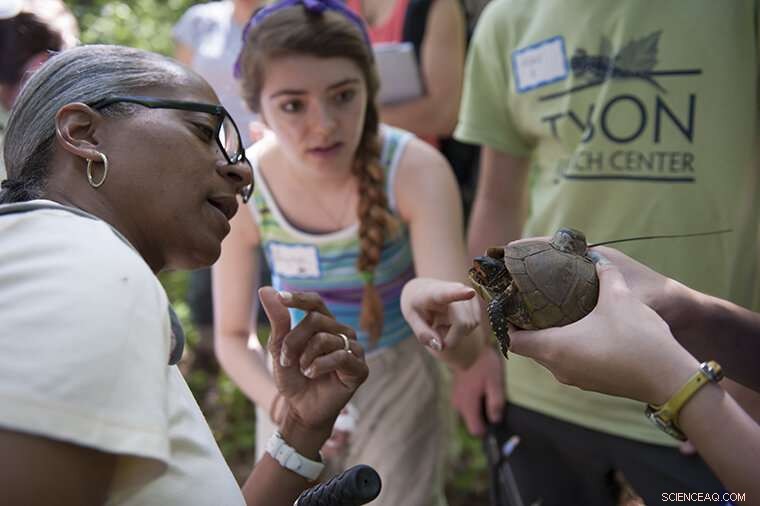
Crédito:Unsplash/CC0 Public Domain
O microbioma é a coleção de micróbios que colonizam um habitat, corpo humano ou outro. Por causa da pesquisa pioneira de microbiomas na Escola de Medicina da Universidade de Washington em St. Louis, as pessoas ao redor do mundo agora entendem muito mais sobre o papel fundamental dos micróbios intestinais na saúde e nas doenças humanas.
Animais e plantas também contam com milhares de micróbios diferentes para ajudar a mantê-los vivos. Embora menos se saiba sobre essas associações, uma nova geração de cientistas está explorando as relações entre um exército oculto de micróbios e as criaturas que eles sustentam e fortalecem. Esses Micróbios de Ecossistemas Diversos (mDivE-STL) são o foco de um simpósio de pesquisa em 3 de outubro organizado pela Living Earth Collaborative.
Em várias instituições de pesquisa em St. Louis, os pesquisadores estudam microbiomas humanos e não humanos. Este simpósio foi organizado para ajudar a promover uma comunidade de pesquisadores que estudam diversos sistemas microbianos enquanto se beneficiam da grande força local na experiência do microbioma humano.
Tomemos, por exemplo, pesquisadores que estudam macacos bugios pretos (Alouatta pigra) na América do Norte e Central. Esses macacos grandes e carismáticos são conhecidos por fazer uma das chamadas mais altas nas florestas tropicais do México, Guatemala e Belize.
Como herbívoros arborícolas, os bugios pretos consomem principalmente folhas de árvores e videiras, flores e frutas. Como carecem de enzimas capazes de digerir a celulose – o carboidrato que compõe a parede celular da folha – os bugios-negros dependem da fermentação desencadeada por sua microbiota intestinal para obter a energia de que precisam desses alimentos.
Todo esse processo pode ser muito mais dinâmico do que se pensava anteriormente, de acordo com pesquisas de cientistas da Universidade de Washington. Estão começando a surgir evidências de que as alterações microbianas intestinais relacionadas à dieta amortecem a disponibilidade de energia e nutrientes para animais como os bugios negros.

Uma tartaruga de caixa selvagem no Tyson Research Center, estação de campo ambiental da Universidade de Washington. Com o apoio da Living Earth Collaborative, os pesquisadores expandiram o St. Louis Box Turtle Project para caracterizar os microbiomas nativos de tartarugas de três dedos. Crédito:Thomas Malkowicz / Universidade de Washington
Elizabeth Mallott, professora assistente de biologia em Artes e Ciências, usa a metabolômica para examinar como o metabolismo microbiano responde a mudanças no que e quanto seus hospedeiros estão comendo. Ela recentemente conduziu um estudo com uma população de bugios-pretos selvagens que anualmente experimentam três estações distintas que afetam suas dietas:uma estação chuvosa, dominada por frutas; uma estação seca, dominada por folhas; e uma estação seca e frutífera.
"Podemos ver que quando os macacos comem mais de um nutriente específico, os micróbios intestinais metabolizam mais esse nutriente", disse Mallott, primeiro autor da pesquisa publicada na
Molecular Ecology . “Mas, além disso, o que foi emocionante é que pudemos observar as interações entre os micróbios e os metabólitos em diferentes estações, incluindo estações em que os macacos eram limitados nutricionalmente ou energeticamente pela comida disponível em seu ambiente”.
Microbes tend to compensate during lean times, Mallott discovered, prioritizing functions that provide more nutrients to the host. But that system falls apart when food availability becomes truly limited.
"Then the microbes seem to be scrambling. They just try to steal as many nutrients from each other as possible," said Mallott, who also looks at how environmental variation impacts the gut microbiome in humans.
Microbes could benefit species conservation Studying the microbiomes of animal populations that thrive in the wild is important because it may provide researchers with candidate microbes and microbial consortia that could be used to improve disease resistance, nutrient absorption and ultimately the fitness of threatened species or animals that reside in degraded habitats.

Visitors take a close look at “Parkey,” a turtle tagged and tracked as part of the St. Louis Box Turtle Project. With support from the Living Earth Collaborative, researchers have expanded the project to characterize the native microbiomes of three-toed box turtles. Credit:Sid Hastings / Washington University
This is true for mammals including black howler monkeys, but also reptiles such as the Missouri native box turtles—including the ones that the Saint Louis Zoo Institute for Conservation Medicine has studied at two sites in the St. Louis area since 2012, as part of the St. Louis Box Turtle Project.
With support from the Living Earth Collaborative, researchers are expanding that effort to include characterizing the microbiomes of three-toed box turtles and exploring how they vary within and between populations. Scientists from the laboratory of Fangqiong Ling, an assistant professor of energy, environmental and chemical engineering at the McKelvey School of Engineering, are collaborating on this turtle project to integrate microorganisms into the wildlife conservation toolbox.
"In general, wildlife microbiomes—the bacteria, archaea, protists and viruses that are found inside and on the body—are an understudied aspect of biodiversity conservation," said Sharon L. Deem, director of the Institute for Conservation Medicine and of the Saint Louis Zoo WildCare Institute Center for Chelonian Conservation.
Deem and Mallott are both scheduled to speak at the Oct. 3 research symposium, which was organized by Ling, Gautam Dantas, a professor of pathology and immunology at the School of Medicine, and Jonathan Losos, the William H. Danforth Distinguished University Professor of biology in Arts &Sciences and director of the Living Earth Collaborative.
About half of the microbiome research that will be presented relates to animals, plants and the environment, while the rest is more closely related to human health.
"You can't really understand the human microbiome and its interesting dynamics if you don't consider it in the context of the environment," said Dantas, who describes the microbiome research in his laboratory as being about 90% focused on humans and 10% in other habitats, including plants, soil and the built environment. "Even if you're purely focused on the microbes in humans, you're not going to be able to explain the important dynamics of those of that ecosystem if you don't understand the interactions in microbes within and on the body, and where those microbes come from."
+ Explorar mais Humans evolved with their microbiomes. Like genes, your gut microbes pass from one generation to the next


